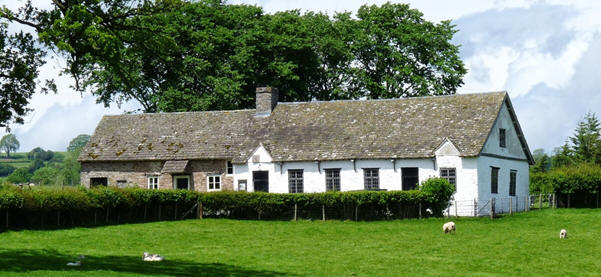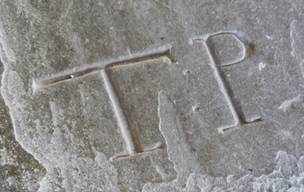 A few years ago we had a group visiting Maesyronnen Chapel from a church in
Cardiff. I was there to lock up after they had finished and was sitting
quietly at the back, listening. Their minister was full of enthusiasm. “This
is it!” he said, “this is it, this is where it all started! This is where
our movement began!”. “Wow” I thought, and I haven’t stopped thinking “wow”
since.
A few years ago we had a group visiting Maesyronnen Chapel from a church in
Cardiff. I was there to lock up after they had finished and was sitting
quietly at the back, listening. Their minister was full of enthusiasm. “This
is it!” he said, “this is it, this is where it all started! This is where
our movement began!”. “Wow” I thought, and I haven’t stopped thinking “wow”
since.You can’t get a chapel much older than Maesyronnen. William & Mary passed the Act of Toleration allowing non-conformist worship in 1689 as part of their “glorious revolution”, and the chapel was registered for worship in nearby Presteigne only 8 years later in 1697. There had been clandestine meetings in secluded farmhouses and buildings across the area before then, dating from the middle of the 1600s after dissenters and nonconformists split from the established church and their movement “spread like wildfire” across the hills and mountains of South Wales. This was despite the threat of violence, imprisonment or even worse and goes someway to explain the chapel’s secluded location. There are some who say the chapel is a converted barn. Indeed, there was a barn – y beudy - on or near to the site of the current building where meetings did take place, with Oliver Cromwell being one of the rumoured worshippers. However, the Royal Commission on the Ancient and Historical Monuments of Wales (RCAHMW) say the building was substantially rebuilt as a chapel, perhaps using material from an earlier building. Even today, you can see the giant wooden cruck frame embedded in the chapel’s walls which may have come from an Elizabethan farmhouse. One day, we hope to get these beams dated properly.
 The thing that marks the chapel out as unique is the fact that it is largely
unaltered from the day it was built. There are chapels founded before
Maesyronnen, but these were knocked down and rebuilt in a grander style in
later years. No, Maesyronnen is unchanged, unique and special – it is a
Grade I listed building. Some of the furniture is contemporary, including the communion
table and the deacons table with its fixed seats, placed in front of the
pulpit in the centre of the building. Cut into the wood on the seat back is
the date 1728 together with the initials “AP”. We have copies of the
indentures going back to 1731 that record how “a meeting place for the
worship of God by protestant dissenters was created” and “the same to be
made use of for as long as the liberty for protestant dissenters should
continue”. This document is signed by 10 gentlemen, amongst the first
trustees of the chapel. One of them, Abraham Penry, shares the initials cut
into the seat back… Even if it’s not the same person, it is a thrill to know
the names of the first men to sit at that table.
The thing that marks the chapel out as unique is the fact that it is largely
unaltered from the day it was built. There are chapels founded before
Maesyronnen, but these were knocked down and rebuilt in a grander style in
later years. No, Maesyronnen is unchanged, unique and special – it is a
Grade I listed building. Some of the furniture is contemporary, including the communion
table and the deacons table with its fixed seats, placed in front of the
pulpit in the centre of the building. Cut into the wood on the seat back is
the date 1728 together with the initials “AP”. We have copies of the
indentures going back to 1731 that record how “a meeting place for the
worship of God by protestant dissenters was created” and “the same to be
made use of for as long as the liberty for protestant dissenters should
continue”. This document is signed by 10 gentlemen, amongst the first
trustees of the chapel. One of them, Abraham Penry, shares the initials cut
into the seat back… Even if it’s not the same person, it is a thrill to know
the names of the first men to sit at that table.
 Painted
on the front of the pulpit, which unusually is in the middle of the long
wall rather than at one end, are the names of all of Maesyronnen’s ministers
going back to the era before the current building existed. This was created
in 1939 and we continue to update it today, hence the mix of styles. In the
wall behind the pulpit you can trace a line of steps that led to a pulpit
seat much higher than today’s. On the outside of the wall, you can see the
wooden board of the old seat extending through the wall. Back inside, above
the pulpit, look how one of the tie beams has been lifted to create a little
more headroom – only necessary today if we have an extremely tall preacher!
Painted
on the front of the pulpit, which unusually is in the middle of the long
wall rather than at one end, are the names of all of Maesyronnen’s ministers
going back to the era before the current building existed. This was created
in 1939 and we continue to update it today, hence the mix of styles. In the
wall behind the pulpit you can trace a line of steps that led to a pulpit
seat much higher than today’s. On the outside of the wall, you can see the
wooden board of the old seat extending through the wall. Back inside, above
the pulpit, look how one of the tie beams has been lifted to create a little
more headroom – only necessary today if we have an extremely tall preacher!
 Dotted
around the floor of the chapel, carved into the flagstones, you may be able
to see various initials. These match some of the names recorded on the
eleven tablets that adorn the interior walls of the building. We assume that
the owners of the initials are buried underneath their inscriptions. The
dates on the tablets are from only a 50 year period in the chapel’s history,
with the earliest from the early
1800s and the latest in the middle of that century. Before then, members
were probably buried in nearby Anglican graveyards, and afterwards in the
chapel’s own graveyard at the rear of the building. There are a couple of
notable inscriptions. One records Elizabeth Bowen, an 8 month old girl who
was ‘the first interr’d in this chapel’ in 1818. Another commemorates
Reverend David Jones who was minister for 50 years and who ‘met with storms
and enemies of the most malignant kind’. Sadly, they also record the tragedy
of everyday life with an inscription simply saying ‘…Three children … which
died in infancy.’
Dotted
around the floor of the chapel, carved into the flagstones, you may be able
to see various initials. These match some of the names recorded on the
eleven tablets that adorn the interior walls of the building. We assume that
the owners of the initials are buried underneath their inscriptions. The
dates on the tablets are from only a 50 year period in the chapel’s history,
with the earliest from the early
1800s and the latest in the middle of that century. Before then, members
were probably buried in nearby Anglican graveyards, and afterwards in the
chapel’s own graveyard at the rear of the building. There are a couple of
notable inscriptions. One records Elizabeth Bowen, an 8 month old girl who
was ‘the first interr’d in this chapel’ in 1818. Another commemorates
Reverend David Jones who was minister for 50 years and who ‘met with storms
and enemies of the most malignant kind’. Sadly, they also record the tragedy
of everyday life with an inscription simply saying ‘…Three children … which
died in infancy.’  There
is a small brass plaque on one of the benches commemorating 2 of our members
who were killed in action in the First World War – you can read about these
men elsewhere. Today, we remember them with a silhouette so they are always
with us, at every service. It was a thrill a while ago to have the medals of
one of the soldiers in chapel, together with a photographic portrait and
other mementos, for an open day. These items were loaned to us for the day
by members of his family who still live locally.
There
is a small brass plaque on one of the benches commemorating 2 of our members
who were killed in action in the First World War – you can read about these
men elsewhere. Today, we remember them with a silhouette so they are always
with us, at every service. It was a thrill a while ago to have the medals of
one of the soldiers in chapel, together with a photographic portrait and
other mementos, for an open day. These items were loaned to us for the day
by members of his family who still live locally. In
1914 the then minister, Reverend Daniel Christmas Lloyd, wrote to the local
newspaper to launch an appeal for funds to repair the chapel roof. About £32
was raised, acknowledged in the same newspaper a few weeks later. Donations
included 10/6 from the local MP. A century or so later, it took more than
3000 times £32 to re-roof the chapel, which wouldn’t have been possible
without the generous support of CADW and others. The result is the chapel
you see today – plain, simple, whitewashed, full of history and ready, with
its dedicated current membership, to create the history of tomorrow.
In
1914 the then minister, Reverend Daniel Christmas Lloyd, wrote to the local
newspaper to launch an appeal for funds to repair the chapel roof. About £32
was raised, acknowledged in the same newspaper a few weeks later. Donations
included 10/6 from the local MP. A century or so later, it took more than
3000 times £32 to re-roof the chapel, which wouldn’t have been possible
without the generous support of CADW and others. The result is the chapel
you see today – plain, simple, whitewashed, full of history and ready, with
its dedicated current membership, to create the history of tomorrow. MRH.